|
Pages 29-34 From Winter
2009 Florida Golf Magazine ©Copyright 2009, All Rights
Reserved. Subscribe at floridagolfmagazine.com/subscribe |
Historic Scotland
The Birthplace O’ Golf
|
|
by Joe Stine |
Picture below is a photo of an 1836
Survey of St. Andrews’ Old Course which is on display at
the World Golf Hall of Fame in St. Augustine Florida. Back then,
St. Andrews’ narrow nine hole track through the thorny gorse
bushes, had no double greens and actually only had ten holes,
eight of which were played twice. To play an eighteen hole round,
it was necessary to play the same holes, going out and coming
in. So, the 1st hole was also used as the 17th hole.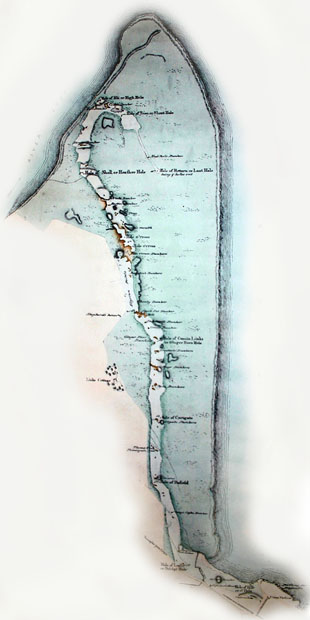
Golf’s history is still being written, but unfortunately
the record of its origin is an incomplete collection of documents
and artifacts. One thing that is certain is that golf began in
Scotland. For it is in Scotland after all that golf has its roots
and its soul. It’s also where the ‘grande auld geme’
is understood and appreciated ‘jist a wee bit’ differently
than anywhere else in the world.
Florida
Golf Magazine decided to visit some of the oldest golf courses
in the world. With this goal in mind, we undertook an extensive
tour of the country that touts itself as being the birthplace
of the game we love.
Map of
Scottish golf courses, from
golfvacationsscotland.com
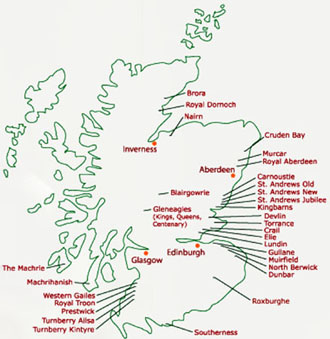
To anyone
planning a golf vacation to Scotland, we would recommend the
use of an experienced
and reputable travel agent. We did some research and contacted
a company called golfvacationsscotland.com
to help us organize a tour of some of Scotland’s truly historic
golf courses, and their guidance proved to be invaluable. |
|
After
speaking with a very personable Irish chap named Eamonn
Kennelly at golfvacationsscotland.com,
it became evident that we could not visit every old golf course
in Scotland, so we decided on whirlwind tour of eight historic
courses in ten days. The folks at golfvacationsscotland.com
made all of the travel arrangements and helped us plan an itinerary
around an eclectic cross-section of historic Scottish golf courses,
which included in order, Gleneagles, Brora, Royal Dornoch, Carnoustie,
Crail, St. Andrews, Kingsbarns and Prestwick.
 |
|
The historic Gleneagles
Hotel
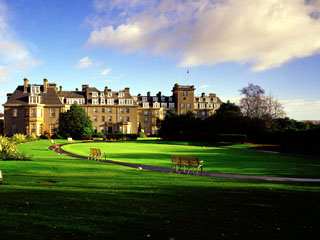 We
started our Scottish golf vacation by flying into Glasgow International
Airport. From there we rented a car and drove to the historic
and luxurious Gleneagles Hotel. They have three courses at Gleneagles, the Kings, Queens and a new course designed by
Jack Nicklaus called the PGA Centenary Course, but we were there
to play the historic King Course design by Open Chapion, James
Braid in 1919 We
started our Scottish golf vacation by flying into Glasgow International
Airport. From there we rented a car and drove to the historic
and luxurious Gleneagles Hotel. They have three courses at Gleneagles, the Kings, Queens and a new course designed by
Jack Nicklaus called the PGA Centenary Course, but we were there
to play the historic King Course design by Open Chapion, James
Braid in 1919
James Braid's
plan for the King's Course was to test the best players' shot-making
skills over the eighteen holes. When they play the King's, the
world's greatest golfers admire the cunning and craft with which
he achieved that goal.
You find
out all about it with your first approach shot. If you have driven
straight and long from the tee, you will have what looks like
a simple pitch to the elevated green. But you must be sure to
select the correct club, because the shot is always a little
longer than you think, with the wind over the putting surface
often stronger than you can feel it from the fairway.
Selecting
the right club for each approach shot is the secret on the King's.
It is certainly one of the most beautiful and exhilarating places
to play golf in the world, with the springy moorland turf underfoot,
the sweeping views from the tees all around, the rock-faced mountains
to the north, the green hills to the south, and the peaks of
the Trossachs and Ben Vorlich on the western horizon.
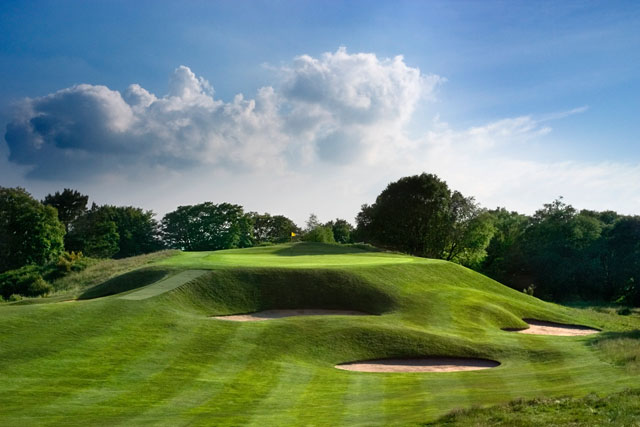
The 5th Hole at Gleneagles, designed
by James Braid |
Gleneagles (Kings Course)
The Gleneagles Hotel
Auchterarder, Perthshire
Founded 1919
Course Architect James Braid
Moorland
Par 71, Length 6790 yards |
Facilities:
Pro Shop Yes
Carts Yes
Caddies Yes
Pull Trollies Yes
Catering Yes |
 |
After
staying two nights at the Gleneagles we drove to Tain, Ross-shire,
and stayed at a marvalous Bed and Breakfast that is owned by
the Glenmorangie Distillery callled the Glenmorangie House, www.theglenmorangiehouse.com
While there
we played two old courses, Brora and Royal Dornoch. The course
at Brora Golf Club was also designed by James Braid. Braid
won The Open Championship in 1901, 1905, 1906 and 1908.
Brora Golf
Club was established in 1891. In 1923 James Braid, five times
Open champion and prolific designer of golf courses, the most
famous of which is Gleneagles, visited the course and redesigned
the 18-hole layout which has stood the passing of time and remains
a fair and challenging test of a true traditional links course. |
Brora Golf Club
Brora, Sutherland
Founded 1891
Course Architect James Braid
Links
Par 69, Length 6110 yards |
Facilities:
Pro Shop Yes
Carts Yes
Caddies
Pull Trollies Yes
Catering Yes |
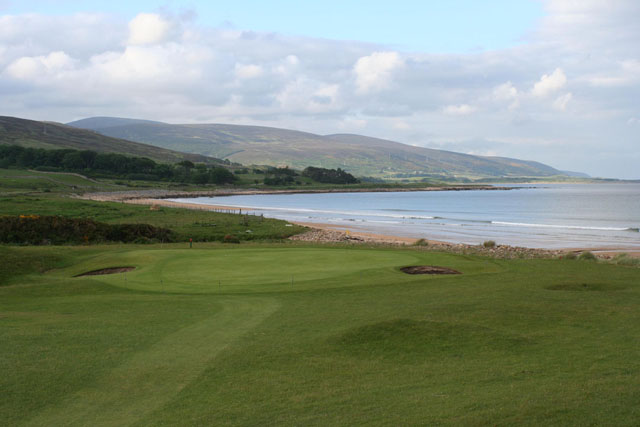
The 9th Hole at the Brora Golf Club, designed by James Braid |
|
As
with all seaside links there are some very special places throughout
this course; the panorama of seascape and landscape from the
second tee, the proximity of the sea to the 9th green and the
beauty of the 13th green, one of the jewels in Braids crown.
Brora golf course represents all the attributes of a traditional
Scottish Highland links, with a classic layout, and well worth
a visit when in this part of Scotland.

The following day we played Royal Dornoch Golf Club which was designed Old Tom Morris. Dornoch,
pronounced with a soft ‘h’.
Royal Dornoch
Golf Club is said to have the northernmost Championship course
in the world. It is of such high quality that many professionals
hone their game at Dornoch leading up to the Open Championship
each year. Its isolation is the main reason for it not having
hosted an Open Championship.
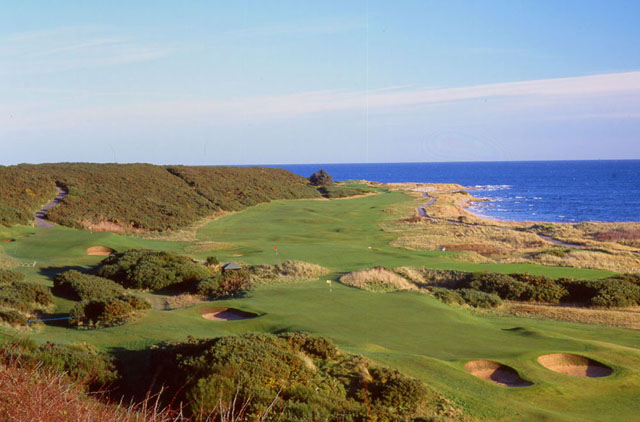
Royal Dornoch the 5th, 6th and 11th
The
course is a typical old links with nine holes running away from
the clubhouse and nine holes coming back. When the gorse bushes
are in flower, it is a magnificent sight and its proximity to
the ocean affords water views on all holes.
Most tees
at Royal Dornoch are elevated high above the level of the fairway
allowing the wind to take your ball at its whim and adding to
the challenge. The greens are generally long and narrow and some
are quite undulating. The putting surfaces are wonderful and
will reward a good stroke.
It is no
surprise that Royal Dornoch is regularly rated among the top
20 courses in the world, and after you play there, you are certain
to agree. |
Royal Dornoch Golf Club
Dornoch, Sutherland
www.royaldornoch.com
Founded 1877
Course Architect Old Tom Morris
Links
Par 70, Length 6,514 yards |
Facilities:
Pro Shop Yes
Carts No
Caddies Yes
Pull Trollies Yes
Catering Yes
Major Events: British Amateur |
 |
|
The next day we drove south to
St. Andrews where we stayed at the beautiful Old Course Hotel
overlooking the Old Course. www.oldcoursehotel.co.uk
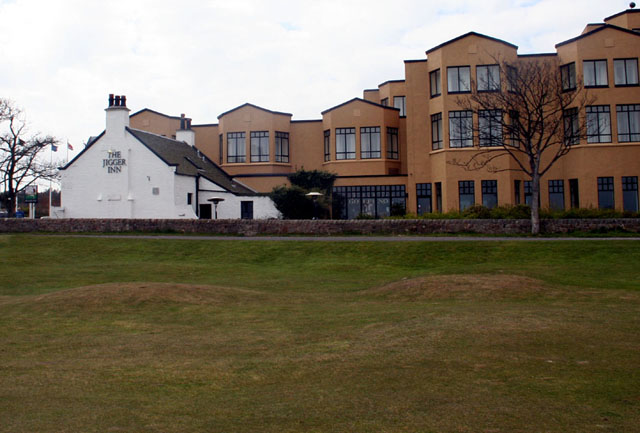
The Jigger Inn and the Old Course
Hotel
While staying in St. Andrews
we played three courses, the first being Carnoustie. The Carnoustie Golf Links, like St Andrews, is a public golf course.
The Championship course has hosted several Open Championships,
most recently in 1999. Sadly, that tournament will be best known
for the 72nd hole antics of Frenchman, Jean Van de Velde, where
he had a triple bogey including a visit to the Burn to force
a playoff with Justin Leonard and the eventually winner, Paul
Lawrie.

The Carnoustie Clubhouse
The
course is widely thought of as the most difficult Open venue.
The wind plays a big part in the way the course is played and
a calm day here is uncommon. The holes are generally long and
are so well bunkered that position off the tee is paramount to
a good score. Carnoustie has no weak holes and requires a well-rounded
game to score well. Accurate chipping to the large greens is
crucial and it is best to avoid the bunkers as they are deep
and well placed.
The finishing
holes are as good a collection as you would find anywhere. The
16th is a punishing par three of over 250 yards to an elevated
green. The 17th is a par four where it is possible to cross the
burn three times during the journey to the green, and the 18th
is a difficult driving hole across the burn and the approach
must also carry the burn as well.
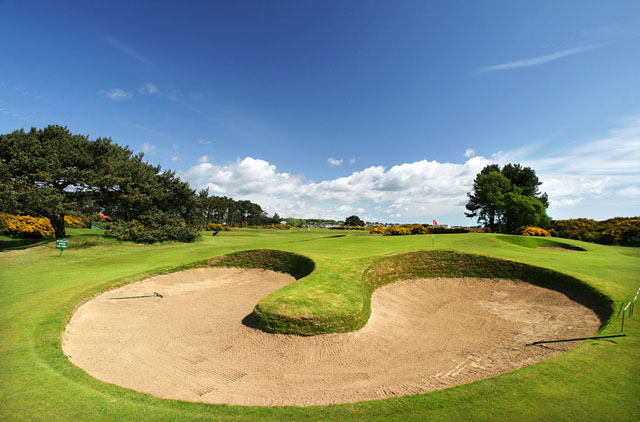
Carnoustie was designed by Alan Robertson in 1842 |
Carnoustie Golf Links
The Links,
Carnoustie, Angus
Founded 1842
Course Architect Alan Robertson
Links
Par 72, Length 6,941 yards |
Facilities:
Pro Shop Yes
Carts No
Caddies Yes
Pull Trollies Yes
Catering in the Hotel complex
Major Events: Open Championship (6 times)
British Amateur (4 times)
Dunhill Links Championship (European Tour) |

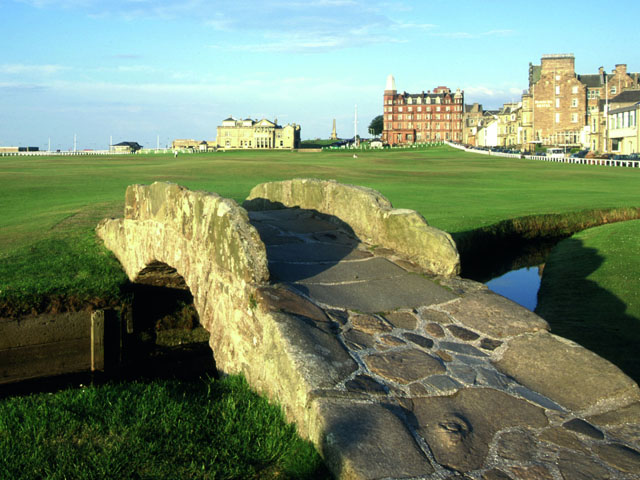
Swilcan Bridge crosses Swilcan Burn on The Old Course in St.
Andrews. St Andrews Links Trust Photo
The
Old Course at St
Andrews is loved or loathed,
appreciated or misunderstood, but as the birthplace of golf,
it is universally respected.
Standing
on the first tee of the Old Course at St Andrews is the realisation
of a dream for many golfers, yet with the widest fairway in the
world ahead, it's amazing how many are overwhelmed by nerves
and put forward a less than ideal beginning to their round.
The subtle
bumps and hollows make for uncertainty on every shot, the placement
of the bunkers and other natural hazards and the varied slopes
and swales on the massive double greens make for a golfing experience
without peer.
The golf
links at St. Andrews is where the game of golf developed for
over six centuries. Hacked through the gorse bushes originally
known by locals as the thorny whins, the Old Course has staged
more Open Championships than any other golf course and has provided
the backdrop for some of golf’s most memorable moments.

The 17th green on the Old Course, dubbed the Road Hole.
Pictured above is the green of the 455 yard dogleg right Road
Hole of the Old Course. Drive over the dark green sheds on the
right side if you dare, and you are still left with a difficult
shot into a shallow green set at 45 degrees to the fairway. Play
it long, and the ball will lie on the road that runs behind the
green. Play it short, and the notorious Road Hole Bunker lies
in wait.
Our caddy
told us that the prudent shot is to the front right corner of
the green. |
The Old Course, St Andrews
St Andrews, Fife
Founded 14th Century
Course Designer Unknown
Links
Par 72, Length 7,115 Yards |
Facilities: Pro Shop Two Clubhouses
(Links and Eden), both with Pro Shops
Carts No
Caddies Yes
Pull Trollies Yes (after midday)
Catering Yes (In both clubhouses)
Major Events: Walker Cup, Curtis Cup, Open Championship (26 times),
Amateur Championship (15 times), Dunhill Links Championship (European
Tour) |

The
day after playing the Old Course we made our way to Kingsbarns Golf Links, and were we ever glad that we did.
Known as the Pebble beach of Scotland, its vistas or breathtaking.
Unknown
to most people Golf has been enjoyed over the links land of Kingsbarns
since 1793. This links served the golfing needs of the locals
and holidaymakers until the onset of the Second World War when
the Links was mined in the national security defence effort and
it quickly reverted to rough pasture.
It's not
surprising that St Andrews locals believe the links at Kingsbarns
will be added to the Open Championship rota in the future. Only
six miles from St Andrews, I agree that Kingsbarns is one of
the finest new courses in the world. If you haven't heard of
Kingsbarns before, you will know all about it in years to come.
Having
converted an old nine-hole course into the magnificent creation
took a great deal of imagination and foresight, and the results
are almost beyond belief. With the sea visible from every hole,
the holes are aesthetically stunning and magnificently designed
to ensure ease of play from several tee locations. The greens
are undulating and roll fast and true.
The 15th,
a par three along the water, is as spectacular a short hole as
you will find anywhere. The final hole demands great courage
with the final 50 yards being over a valley with a burn waiting
below to swallow your ball
A small
number of courses are worth raving to your friends about, and
this is certainly one of them. You will love it!
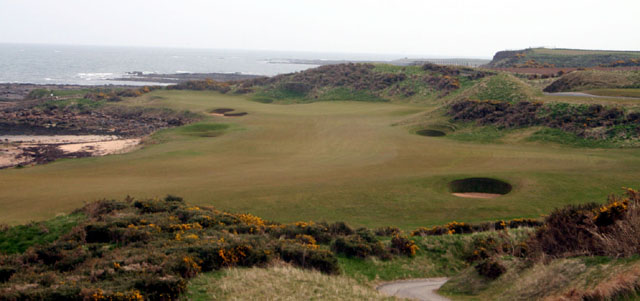
Kingsbarns Golf Links, called
the Pebble Beach of Scotland, has to be seen to be believed. |
Kingsbarns Golf Links
Kingsbarns, Fife
Founded 2000
Course Architect Kyle Phillips, Mark Parsinen
Links
Par 72, Length 7,126 yards |
Facilities:
Pro Shop Yes
Carts No
Caddies Yes, on prior application
Pull Trollies Yes
Catering Yes
Major Events:
Dunhill Links Trophy (European Tour) |

Located
10 miles along the Fife coast from St Andrews, the Balcomie Links
at the Crail Golfing
Society is the 7th oldest
club in the world.
Crail is
one of the old, classically designed courses in Scotland. The
sea comes into play on a number of holes, where a decision to
gamble with the beach or take the easier dog-leg has to be made.
Positioning of the tee shot is more important than length on
most holes and some of the finest short holes to be found on
any course will be a lasting memory.
This course
was first used permanently by the Society in 1895, when it was
opened by Tom Morris who stated 'there is not a better course
in Scotland'. The Balcomie course had been in existence long
before this and there is a record of a society competition being
played in September 1857.
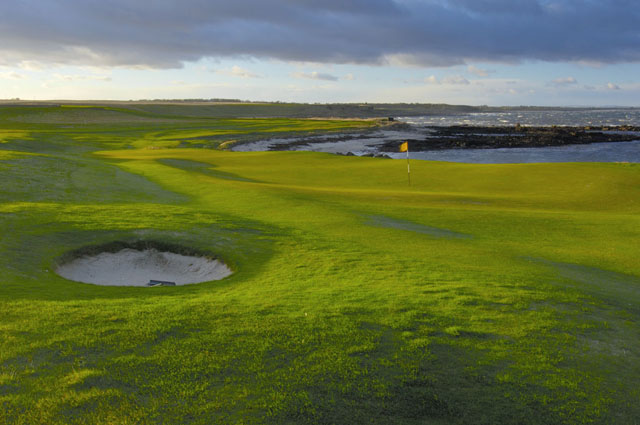
3rd green looking to 4th green of Crail’s Balcomie Links |
Crail Golfing Society
(Balcomie Links)
Founded 1786
Course Architect Old Tom Morris
Links
Par 69, Length 5922 yards |
Facilities;
Pro Shop Yes
Carts No
Caddies On application
Pull Trollies Yes
Catering Yes |

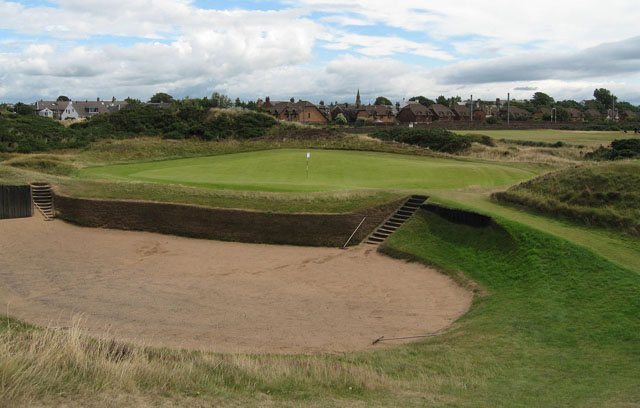
Sahara bunker and 17th Green
at Prestwick
The
Old Course at Prestwick was the original host of the tournament
that became the Open Championship, the most sought after prize
in world golf. It was used for the first 12 Opens and has hosted
the tournament on 24 occasions in total.
It is not
long enough by today's standards to be on the current Rota of
Open courses but remains a fine example of traditional Scottish
links golf. In places, it is a tight and testing layout, where
position rather than power is prized. In fact, on some holes,
length can get you into more trouble than more conservative play.
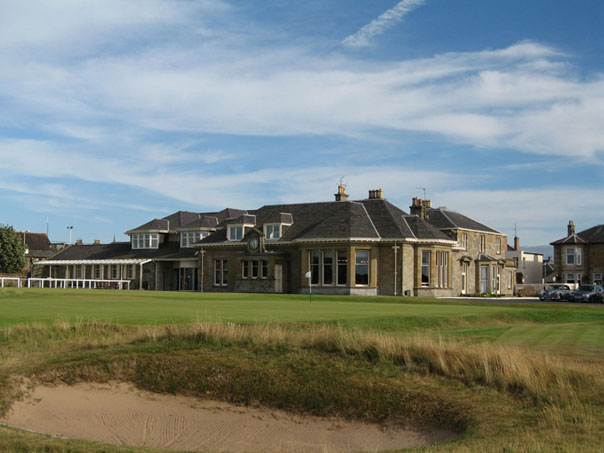
Prestwick Golf Club, 18th Green and Clubhouse
At
first glance, Prestwick appears conservative and at peace with
its place in the history of golf, however in fact it is a relaxed
and friendly club that enjoys hosting golfers from all around
the world. Visitors are encouraged to use their temporary membership
to its full capacity, and enjoy the full lunch in the lavish
Dining room or just a snack in the relaxed Cardinal room.
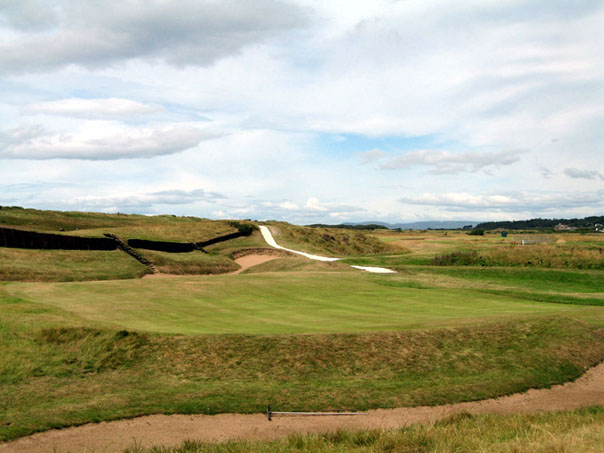
Cardinal Bunker and 3rd Hole
at Prestwick Golf Club |
Prestwick Golf Club
Links Road,
Prestwick, Ayrshire, Scotland
Founded 1851
Course Architect Old Tom Morris
Links
Par 71
Length 6,544 yards |
Facilities:
Pro Shop Yes
Carts No, Pull Trollies Yes
Caddies Yes, on application
Catering Lounge, Bar & Dining room is available. Jacket,
Collar & Tie required
Major Events: Open Championship (24 times)
Amateur Championship (10 times) |
|
Prestwick
is arguably one of the most important old Scottish courses in
the history of golf, second only to the Old Course at St. Andrews.
If you golf in Scotland, it would be a mistake to not play Prestwick. |
|
|
|
Pages 29-34 From Winter
2009 Florida Golf Magazine ©Copyright 2009, All Rights
Reserved. Subscribe at floridagolfmagazine.com/subscribe |
|